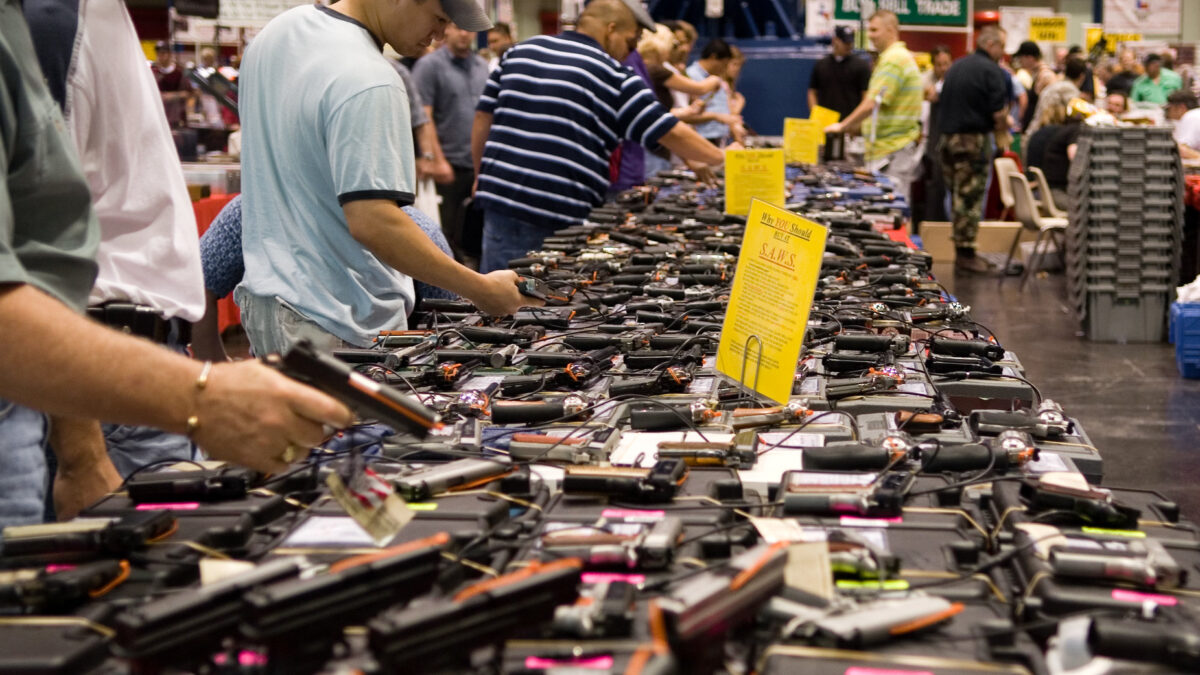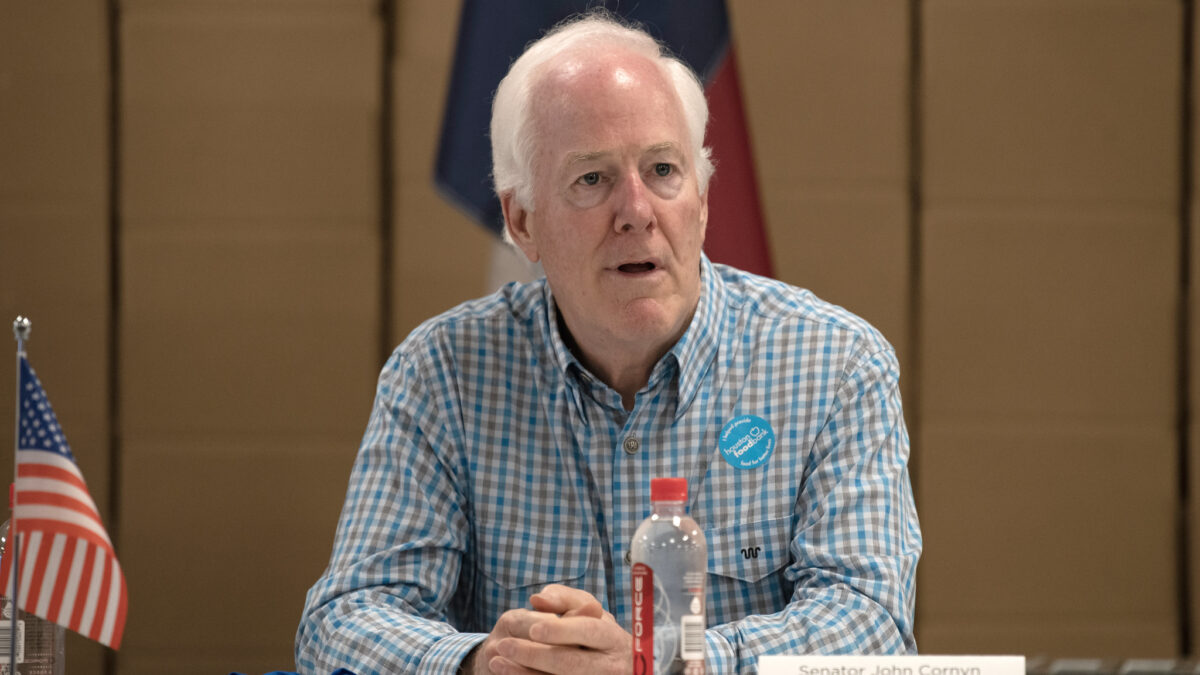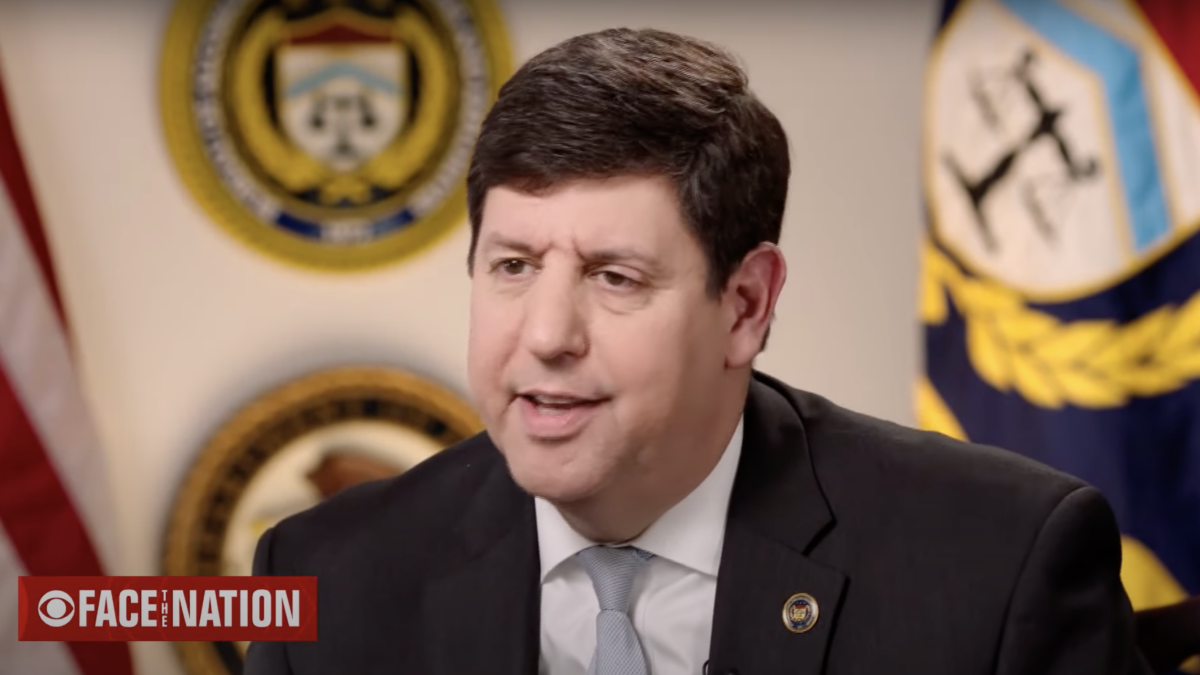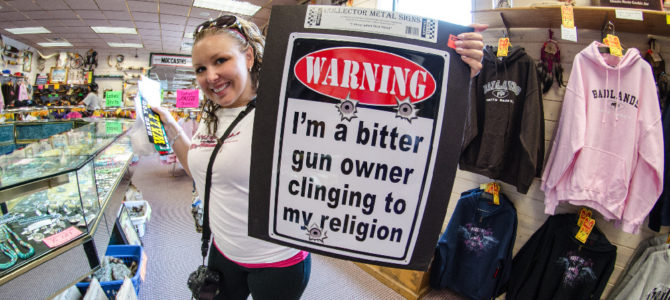
Newsweek recently published an article with a provocative title: “Was Stephen Paddock Normal? Many Gun Owners Keep 17 Firearms on Average.” This article was based on a survey Northeastern and Harvard universities performed in 2015.
As an economist, I swim in the sea of data every day. The words “most” and “on average” always make me suspicious. Another warning sign was that several authors of the study are housed in schools of public health, notorious for bad statistical methods. So I went looking for sources and methods. Here are my conclusions.
The survey itself is most likely flawed. There have been several interviews and press releases, but no full study results in an academic publication. When press releases come out before the peer-reviewed study is published, caution is in order.
The results of the survey are not consistent with data from other sources, and the Newsweek article states, “The number of gun owners has declined since 1994, from around 25 percent to 22 percent of the population, according the Harvard/Northeastern survey.” This is factually incorrect. The number of gun owners has increased because the U.S. population has increased.
The “news” outlets that received press releases from the researchers are The Trace and The Guardian. Both oppose gun ownership. Further, at least a few of the researchers have expressed strong anti-gun sentiments in public. Let’s look at each of these factors in greater detail.
Is It Common for People to Stockpile Guns?
The most sensational piece of data is that 7.7 million people own “a number of guns.” How many? Here’s what The Trace article says: “That top 14 percent of gun owners — a group of 7.7 million people, or 3 percent of American adults — own between about eight and 140 guns each. The average is 17.”
I’m not sure who made this rookie mistake, but the mean of a skewed distribution is not the correct measure of central tendency. The average includes data from the far right end of the distribution—people who own, say, 140 guns. But the left end of the distribution is truncated. In other words, the mean will be greater than the median. And the median is the correct measure to use: half the data points will be on each side of the median. Their most important claim uses the wrong figure.
But let’s ignore that. 7.7 million Americans own eight or more guns. That’s 11 percent of all gun owners. The real question is: Why anyone would own eight, 17, or 140 guns? It’s easy to get to four or five. One or two handguns for self-defense, a shotgun for scaring away flocks of birds, a 22-caliber rifle for eliminating predators from your garden or chickens, a larger gun for hunting. But that’s less than the mean and probably less than the median within this group.
A clue is to be found in a more recent survey Pew Research Center published in spring 2017. In a wide-ranging survey, the Pew researchers asked many interesting questions. One is relevant to the topic at hand: “percentage of gun owners saying each is a major reason why they own a gun.” This question allowed multiple responses, so the percentages don’t add to 100 percent.
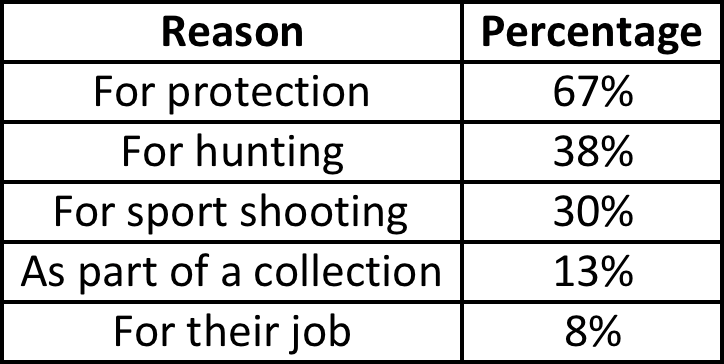
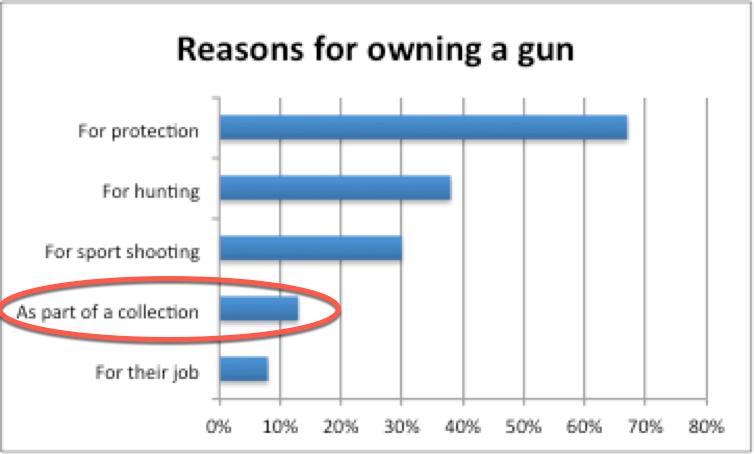
That 13 percent figure looks familiar. The Northeastern/Harvard study says 11 percent of gun owners have eight or more firearms. It’s only a short leap of logic to infer that those who own many guns are mainly collectors.
Gun Owners Are Increasingly Less Likely to Tell
Added insight comes from a Zogby/O’Leary survey in 2015. It includes this tidbit: “‘QUESTION: If a national pollster asked you if you owned a firearm, would you determine to tell him or her the truth or would you feel it was none of their business?”
Gallup recently released a poll showing gun ownership had declined compared to polls they’d taken earlier. That number is inconsistent with the number of firearms that have been sold since President Obama took office as president, but the difference can be answered by the Zogby Analytic question above. The poll indicates maintaining anonymity is a contributing factor: “36% of Americans feel it is none of the pollster’s business and that includes 35% of current gun owners 47% of Republicans and 42% of Independents.”
That means only 65 percent of gun owners today will reveal that fact to a pollster. Let’s assume that has not always been true. Increasing calls for gun confiscation from progressives have provided quite an incentive to not answer questions about gun ownership.
We can combine the Zogby/O’Leary results with an additional piece of data from the NORC General Social Survey (GSS). In many years they include this question: “Do you happen to have in your home (IF HOUSE: or garage) any guns or revolvers?” In 2016, 593 respondents answered yes (32.25 percent) while 1,246 said no. But let’s assume the Zogby/O’Leary results are true. In that case, the true percentage of households where a gun is present is 32.25%/65% = 49.61%.
The GSS asked the same question in 1974, 1976, and 1977. Let’s assume the figures from the 1970s are accurate. The average percentage of yes responses in those three years is 47.87 percent. In other words, gun ownership has been pretty stable over the past 40 years. But the GSS survey includes more responses than simply “yes” or “no.” One interesting answer is “refused.” In 2008 1.11 percent of respondents refused to answer. In 2010 that figure had almost tripled to 3.29 percent. Here’s the complete series.
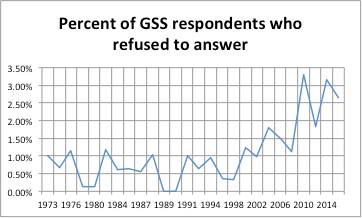
The absolute number of those who refused to answer hit its maximum of 54 in 2014. The small number of respondents undoubtedly explains a lot of the variability in this graph. But the sharp increase in the refusal rate that started in 2010 shows no signs of falling back to the rates seen in the 1970s. This data seems to be consistent with the Zogby/O’Leary survey results.
We can infer that most owners of eight or more guns are collectors. And it’s clear that the percentage of households where a gun is present has remained fairly constant (after correcting for refusals to answer). Now let’s turn to the sources of the stories.
The Trace and The Guardian
Only two media outlets received unsolicited information about this study. The Trace makes no bones about where they stand: “The Trace is an independent, nonpartisan, nonprofit journalism startup dedicated to shining a light on America’s gun violence crisis.”
In fact, Newsweek is one of their media partners:

The Newsweek article quotes tweets by two individuals. One is Miles Kohrman:
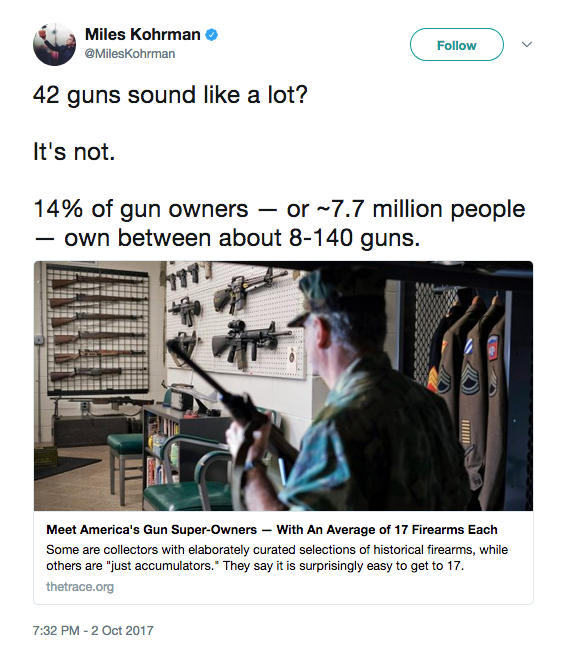
Kohrman’s name turned up in an interesting place: The Trace “About” page.
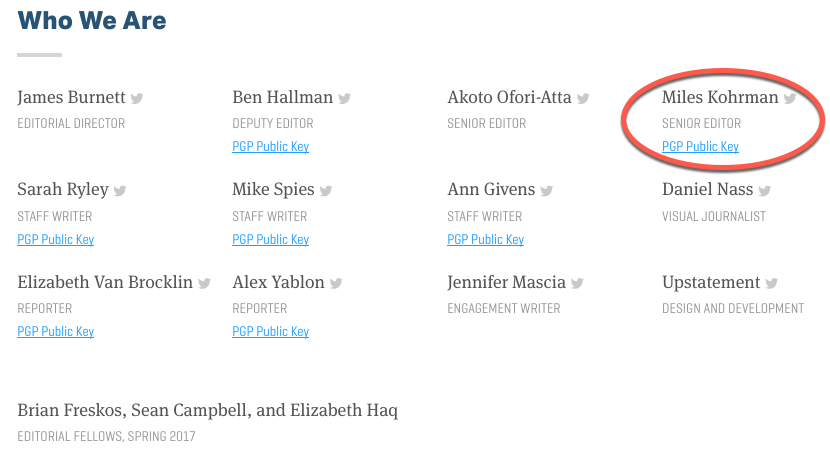
Perhaps Newsweek might have informed us of Kohrman’s affiliation, not to mention their affiliation with this organization. The Guardian is at least a bit more circumspect. But here’s an interesting quote in its article: “The unpublished Harvard/Northeastern survey result summary, obtained exclusively by the Guardian and the Trace, estimates that America’s gun stock has increased by 70m guns since 1994. At the same time, the percentage of Americans who own guns decreased slightly from 25% to 22%.”
Unpublished and released to exactly two outlets. At least The Guardian was willing to include some skeptics: “Some gun owners responded to the study’s findings with trepidation. Bryce Towsley, a Vermont-based gun writer and the author of Prepper Guns, a firearms guide for survivalists, said he worried about how the survey would be used politically. ‘They’re going to say, “Okay, there’s a small minority of people who have all the guns – we’re going to go after them.”’
Here are The Guardian’s most recent seven articles under the topic “gun control.” All seven of these articles and opinion pieces favor gun control.
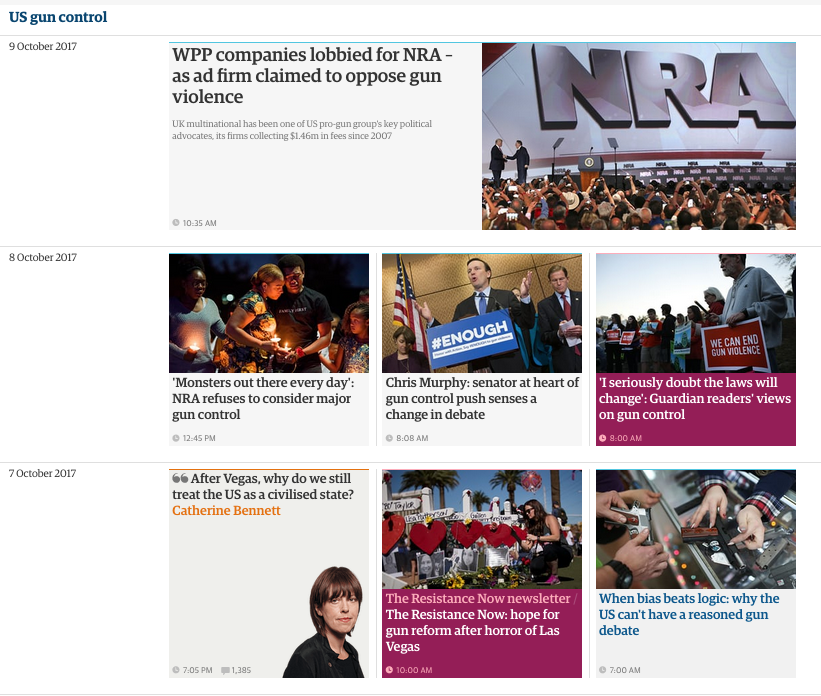
Now for the People Involved in Making This Study
Professor Matthew Miller of Northeastern University is one of the four co-authors of the study in question. He has posted his curriculum vitae online. Here’s the citation from that document: “Azrael D, Hepburn L, Hemenway D, Miller M. The Stock and Flow of US Firearms: Results from the 2015 National Firearms Survey. Russell Sage Foundation Journal of Social Science. 2017. In Press.”
One name stands out on this list: Deborah Azrael. In a 2015 interview with Salon she made this comment: “To me the fundamental problem is that everything we know suggests that access to firearms increases the likelihood of death and injury. Disproportionately to women, disproportionately to children, but to everyone. The notion that somehow increasing access to guns to women is going to be an exception to that rule is, to me, unfounded.”
There’s just one problem: the data does not support her statement. Dr. John Lott has studied this extensively. His book “More Guns, Less Crime: Understanding Crime and Gun Control Laws” (3rd edition, 2010, University of Chicago Press) makes this point in great detail. His methodology and data are available on the Crime Prevention Research Center (CPRC) website. One example is what happens to the murder rate after gun restrictions are imposed. Here are the results from Chicago and Washington DC.
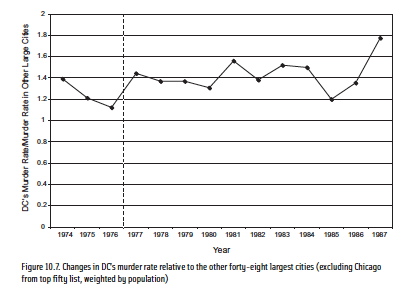
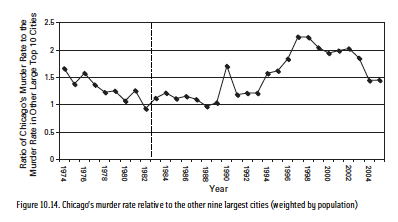
In both cities, the murder rate increased after major gun restrictions were imposed. Lott has much more data and empirical work on the CPRC website.
Lott has a Ph.D. in economics from the University of California at Los Angeles, a highly regarded program. Perhaps anti-gun public health “professionals” should take a few genuine statistics courses so they can understand his work. And, no, the biostatistics course they took in their public health degree programs is not included in that category. However, discussing the flaws in biostatistics is a topic for another article.


